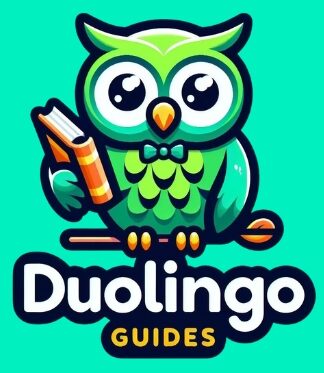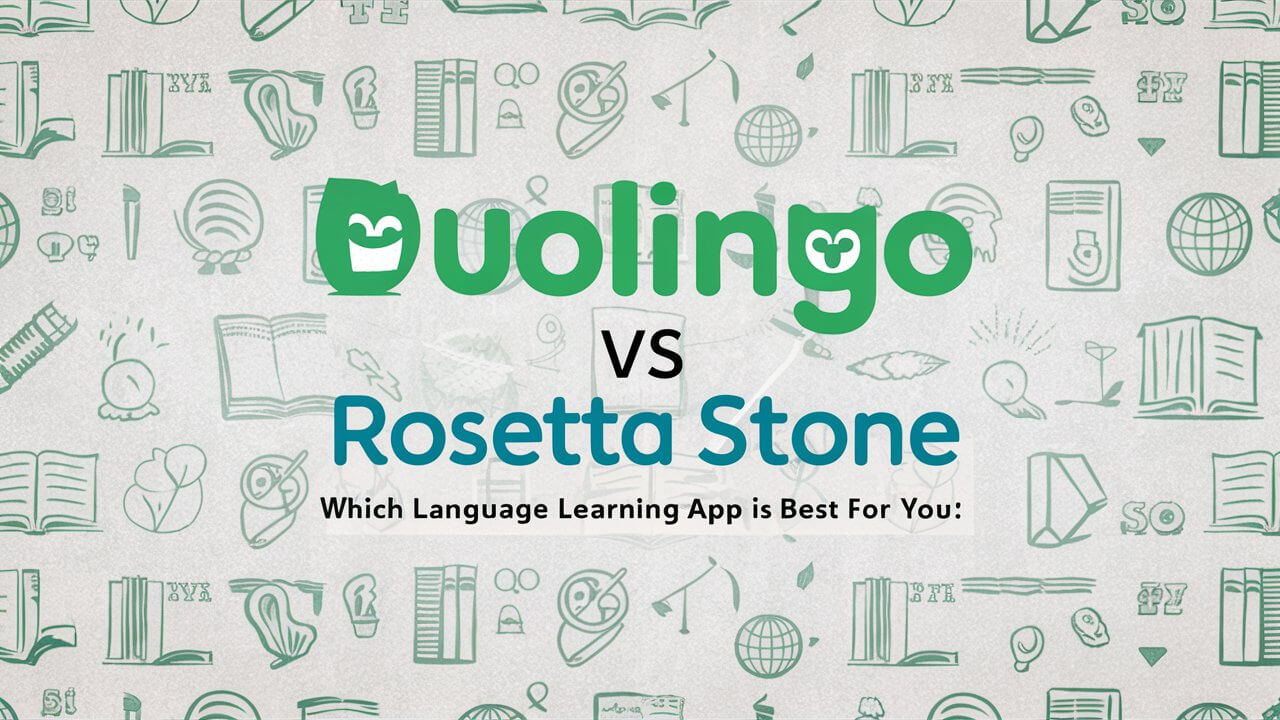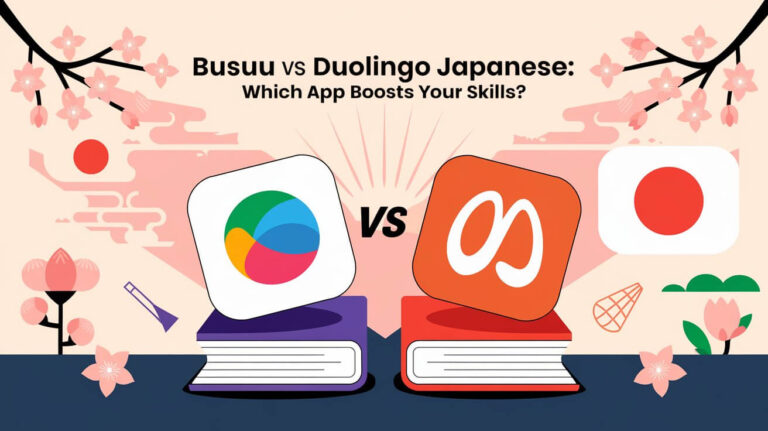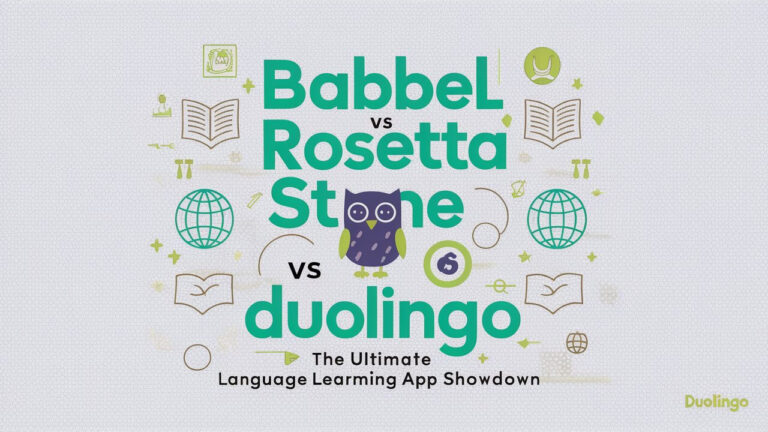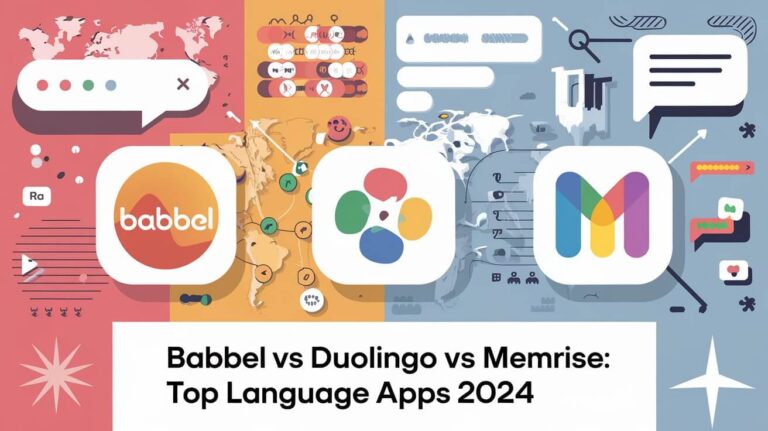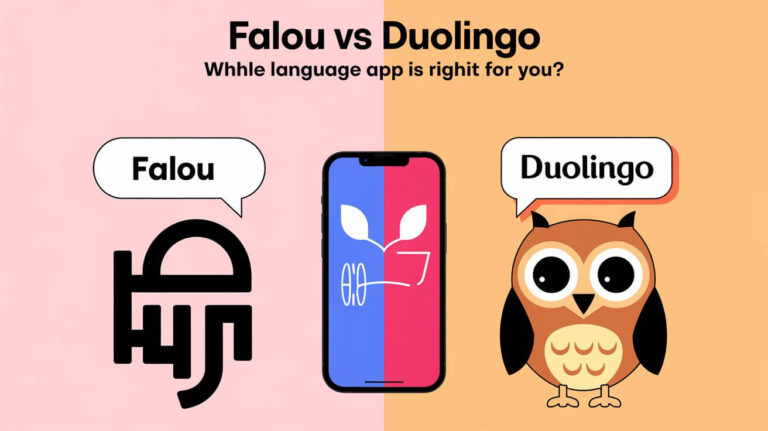In the world of language learning, Duolingo and Rosetta Stone are leaders. They offer different ways to learn new languages. Duolingo uses games and is free, with exercises that help you fill in the blanks and move through themes.
Rosetta Stone focuses on full immersion. It uses listening and matching images with what you hear. It also has special technology called TruAccent™ to help with speaking.
Looking closer at duolingo vs rosetta stone, we see their unique benefits. Each fits different learning styles and goals. So, it’s important to choose the one that best suits you.
Language Learning Platforms Introduction
The landscape of language learning has evolved significantly. Digital platforms like Duolingo, Rosetta Stone, and Babbel are leading the way. They offer different ways to learn languages, fitting many learning styles, goals, and budgets.
Duolingo is a free app that makes learning fun with games. Rosetta Stone, once expensive, now offers a subscription service. It teaches through visuals.
Duolingo is great for fun, but its sentences are sometimes weird. Rosetta Stone has been criticized for not teaching grammar well and for cultural mistakes.
Yet, both platforms stress the need to practice outside the app. They help with real-life language skills and talking to native speakers.
“Language learning platforms have evolved significantly, catering to different learning styles, goals, and budgets, making language learning more accessible than ever before.”
These platforms keep improving, giving people many ways to learn new languages. Each has its own strengths and weaknesses.
Duolingo vs Rosetta Stone: Core Teaching Methods
Duolingo and Rosetta Stone have different ways of teaching languages. Duolingo uses translation and games to keep learners interested. Rosetta Stone focuses on learning through pictures and real-life situations.
Picture-based Learning
Rosetta Stone teaches by using pictures and context, not direct translations. This method helps learners understand the language naturally. It’s like how kids learn their first language.
Translation Methods
Duolingo, on the other hand, uses more translation exercises. It has games and rewards to keep learners motivated. This makes learning fun and engaging.
Speech Recognition Technology
Both Duolingo and Rosetta Stone use technology to improve speaking skills. Rosetta Stone’s TruAccent™ gives detailed feedback on pronunciation. Duolingo’s technology is simpler but effective.
Duolingo helps build habits and makes learning fun through games. Rosetta Stone focuses on learning by immersion and intuition. The best choice depends on what each learner wants to achieve.
Pricing Structure Analysis
Duolingo and Rosetta Stone offer different pricing options for language learners. Duolingo’s free version is supported by ads, making it affordable. For a deeper learning experience, Duolingo Plus costs $6.99 a month.
Rosetta Stone has changed its pricing to be more budget-friendly. Their prices start at $7.99 a month and can reach $11.99. They also offer a lifetime access option for those who want to learn without ongoing payments.
| Platform | Pricing Range | Subscription Options |
|---|---|---|
| Duolingo | $6.99/month | Free version (ad-supported), Duolingo Plus |
| Rosetta Stone | $7.99 – $11.99/month | Monthly, annual, and lifetime subscriptions |
Both Duolingo and Rosetta Stone sometimes have sales and discounts. This lets users get their services at a lower cost. By looking at their pricing, learners can choose the best option for their budget and learning style.
Platform User Experience and Interface Design
Language learning platforms focus a lot on how users feel and interact with them. Duolingo and Rosetta Stone take different paths to meet the needs of today’s learners. They aim to make learning fun and effective.
Mobile App Features
Duolingo uses bright colors and fun characters to keep users excited. It offers short lessons and games to track your progress. Rosetta Stone’s app is sleek but has fewer features than its desktop version.
Desktop Version Capabilities
Rosetta Stone’s desktop version is more detailed, with tools and resources for deeper learning. It has better speech recognition and lessons. Duolingo’s desktop and mobile versions are similar, making it easy to switch between devices.
Offline Learning Options
Duolingo Plus and Rosetta Stone offer offline learning. This is great for those without constant internet. You can download lessons to keep practicing offline.
Duolingo and Rosetta Stone meet different needs with their designs. Duolingo’s fun, mobile-first approach attracts many. Rosetta Stone’s desktop focus and advanced features appeal to serious learners.
Language Course Selection and Availability
Duolingo and Rosetta Stone both offer a wide range of languages. Duolingo has 40 languages, including Navajo, Yiddish, and Klingon. This caters to many different interests in language learning.
Rosetta Stone focuses on 25 languages, like Spanish, French, German, and Italian. While it has fewer options, it covers many popular languages. This ensures learners have plenty of choices.
| Language Options | Duolingo | Rosetta Stone |
|---|---|---|
| Number of Languages | 40 | 25 |
| Language Variety | Includes less common languages like Navajo, Yiddish, and Klingon | Focuses on popular languages like Spanish, French, German, and Italian |
| Language Proficiency Levels | Structured in skill-based units, without traditional beginner to advanced levels | Offers 4-5 proficiency levels for each language, with 12 or 20 units per language |
Both Duolingo and Rosetta Stone offer a wide range of language learning options. They cater to different learner preferences and goals. The choice between them depends on the languages you want to learn and the level of instruction you need.
Learning Path Progression System
Duolingo and Rosetta Stone help you learn a new language step by step. Duolingo uses a tree-like structure with many modules and levels. You start at the right level after a test, building your skills slowly.
Rosetta Stone has five levels, each with its own themes. You move from basic language to more conversation skills as you progress.
Skill Level Assessment
Both platforms focus on finding the right level for you. Duolingo checks your strengths and weaknesses, then gives you lessons to improve. Rosetta Stone uses the CEFR to check your level, from beginner to expert.
Course Structure
- Duolingo makes learning fun with points, competitions, and new content.
- Rosetta Stone teaches through language only, helping you speak naturally.
- Both offer ways to track your progress and achievements.
Looking to start or improve your language skills? Duolingo and Rosetta Stone have systems to help. They support your language learning progression, skill assessment, and course levels.
Immersion and Teaching Philosophy
Duolingo and Rosetta Stone have different ways of teaching languages. Rosetta Stone focuses on complete language immersion. It avoids translations and uses context and repetition to teach. This method tries to mimic how we learn our first language, without using our native tongue.
Duolingo also uses some immersion, but it focuses more on translation and teaching grammar. This method is good for learners who like to understand language in a more structured way. But it’s different from Rosetta Stone’s pure immersion approach.
“Rosetta Stone’s immersion-based approach seeks to replicate the way we learn our first language, focusing on context and repetition, not translation and grammatical rules.”
Rosetta Stone uses language immersion techniques to help users learn naturally. This is different from Duolingo’s method, which uses more traditional learning tools like translation. Duolingo’s approach is more structured and grammar-focused.
Whether to choose Duolingo’s structured method or Rosetta Stone’s immersive approach depends on the learner. Both platforms have their own strengths, meeting different language learning needs and preferences.
Time Investment and Lesson Duration
For those with busy lives, the time needed for language learning is key. Duolingo offers short 5-20 minute sessions daily. This fits well for those looking for quick, regular language practice. On the other hand, Rosetta Stone’s lessons are about 30 minutes long, asking for a bigger time commitment.
Daily Practice Requirements
Duolingo makes daily language learning a habit. It encourages users to do short lessons every day. This makes it simple to add language practice to a busy schedule. Duolingo uses games to keep users motivated and moving forward.
Study Session Length
Rosetta Stone, on the other hand, focuses on longer study sessions. Its lessons aim to give a deeper language learning experience. They use repetition and context to help learners become proficient. This method might take more time but suits those who want to dive deep into a language.
| Feature | Duolingo | Rosetta Stone |
|---|---|---|
| Lesson Duration | 5-20 minutes | Around 30 minutes |
| Daily Practice | Encouraged through gamification and habit-building | Requires more dedicated time commitment |
| Approach | Bite-sized, consistent practice | Comprehensive, immersive lessons |
Choosing between Duolingo’s short sessions and Rosetta Stone’s longer lessons depends on your learning style and schedule. Both platforms cater to different learners, each with their own time and learning needs.
Grammar and Vocabulary Development
Learning a new language means mastering grammar and vocabulary. Duolingo and Rosetta Stone help in different ways. They meet the needs of various learners.
Duolingo uses explicit grammar instruction and vocabulary building in themed lessons. It teaches grammar rules through translation and context. This method builds a strong grammar base and expands vocabulary.
Rosetta Stone takes a different path. It doesn’t focus much on grammar teaching. Instead, it lets users infer grammatical rules from context and repetition. It introduces vocabulary through picture associations for a more natural learning experience.
Both Duolingo and Rosetta Stone have their own ways to teach language grammar lessons and vocabulary building. They cater to different learning styles and goals. It’s important for learners to choose the platform that fits their grammar-focused learning needs.
Speaking and Pronunciation Features
Mastering a new language means getting your pronunciation right. Duolingo and Rosetta Stone help with this, but they do it differently.
Voice Recognition Accuracy
Rosetta Stone uses TruAccent™ speech recognition. It checks how well you sound like a native speaker. This helps fix any mistakes and makes your speech sound natural.
Pronunciation Feedback
Duolingo also has speaking exercises. But its speech recognition isn’t as advanced as Rosetta Stone’s. It does let you compare your voice to native speakers, though.
Both Duolingo and Rosetta Stone know how key language pronunciation practice is. They use speech recognition in language apps to help with accent improvement. Rosetta Stone gives more detailed feedback and practice.
Cultural Integration in Lessons
Language learning isn’t just about words; it’s also about culture. Duolingo and Rosetta Stone, two big names in language learning, have different ways of adding cultural lessons to their courses.
Duolingo is known for making learning fun and easy. It includes cultural references and sayings in its lessons. But, some say its sentences are weird or not used in everyday life. Duolingo Stories, available in some languages, tries to add more cultural depth through stories.
Rosetta Stone, on the other hand, has been criticized for not focusing enough on culture. It often uses American examples and images in its lessons. This approach helps with learning the language but misses out on cultural insights and social rules.
To really get good at a language, you need to understand its culture. Language and culture are closely tied. Knowing cultural norms and customs is key to communicating well.
“Language is the road map of a culture. It tells you where its people come from and where they are going.” – Rita Mae Brown
The best language learning platforms will mix cultural lessons with real-life examples. This way, learners can feel confident when talking to people from different cultures.
Achievement and Progress Tracking
Duolingo and Rosetta Stone are great at making users feel like they’re getting better. They use different ways to show progress and achievements.
Gamification Elements
Duolingo uses games to keep users excited and motivated. It gives points, levels, and “lingots” for finishing lessons and hitting milestones. Users can also compete and keep streaks to feel like they’re in a friendly race.
Rosetta Stone focuses more on real language skills. It has achievements and shows your progress, but it doesn’t have as many game-like features as Duolingo. It aims to make learning a new language feel like a real journey.
Motivation Systems
Duolingo’s games are made to make users feel rewarded and accomplished. Its tracking and alerts help users stay on track. For those who love games, Duolingo is a great way to keep learning.
Rosetta Stone, on the other hand, aims to make learning a new language rewarding in its own way. It focuses on skills you can use in everyday life. It’s perfect for those who like a more structured, step-by-step learning experience.
In the end, whether you choose Duolingo’s games or Rosetta Stone’s traditional method depends on what you like. It’s all about finding what motivates you to keep learning.
Extended Learning Resources
Duolingo and Rosetta Stone offer more than just language lessons. They have tools to help learners improve and use their skills. These tools make learning fun and help learners dive into the language and culture.
Duolingo Stories and Podcasts
Duolingo has interactive short stories for some languages. These stories are told by native speakers. They help learners get better at reading and listening in a real-life way.
They also have podcasts for those who are a bit more advanced. These podcasts talk about different topics and conversations. They help learners use their language skills in everyday life.
Rosetta Stone’s Supplementary Features
Rosetta Stone has a Phrasebook with useful phrases for daily life. They also have an augmented reality game called Seek & Speak. It lets learners find objects and practice vocabulary.
They also have short stories called “Experiences.” These stories help learners get more into the language and culture.
Duolingo and Rosetta Stone both want to help learners with more than just lessons. They offer additional language learning tools, language learning stories, and language podcasts. These resources help learners get better, understand cultures, and have a fun learning experience.
Business Model and Platform Focus
Duolingo and Rosetta Stone are big names in language learning. They have different business models. Duolingo is free but offers a paid upgrade for extra features. This makes it easy for more people to learn languages, even if they can’t pay for a course.
Rosetta Stone, on the other hand, costs between $179 and $479 for a subscription. It’s not as cheap as Duolingo. But, Rosetta Stone gives a better experience without ads. It also has live classes and advanced voice tech called TruAccent to help you learn.
| Feature | Duolingo | Rosetta Stone |
|---|---|---|
| Pricing Model | Freemium (free with ads, paid subscription) | Paid subscription (ranging from $179 to $479) |
| Language Availability | 31 languages for English speakers | 30+ languages |
| Focus Areas | Grammar and vocabulary | Vocabulary, grammar, and sentence structures |
| Voice Recognition Technology | Limited voice recognition | TruAccent voice recognition technology |
| Live Classes | No live classes | Offers live one-on-one classes |
In short, Duolingo wants to make learning languages easy and free for many. Rosetta Stone, with its paid model, aims to give a more detailed and premium learning experience. Both have their own strengths and meet different needs in the language learning world.
Real-world Application and Effectiveness
Language learning platforms are judged by how well they help you use what you learn in real life. Duolingo and Rosetta Stone both aim to make you fluent. But they go about it in different ways.
Conversational Skills Development
Rosetta Stone focuses on making you good at talking. It uses methods that make you feel like you’re really in a conversation. It also offers live tutoring to help you practice.
This makes Rosetta Stone stand out from Duolingo. Duolingo is often seen as teaching simple phrases that don’t help much in real talks.
Practical Usage Benefits
- Rosetta Stone’s methods and live tutoring help you get ready for real-life conversations.
- Duolingo’s fun games and short lessons are engaging. But they might not give you the depth you need for everyday use.
- Both platforms are good as extra tools, but you’ll need more practice to really get fluent.
Duolingo and Rosetta Stone both have their strengths and weaknesses. They help you learn a language, but how well you can use it in real life depends on your goals and how you learn best.
Target Audience Analysis
Duolingo and Rosetta Stone serve different types of language learners. Duolingo is great for those who want to learn a new language in a fun way. It offers games and short lessons that fit well into a busy schedule.
Rosetta Stone is for those who are serious about learning a language. It focuses on grammar and is good for people who need to learn for work or travel. It’s not the best choice for casual learners, but it’s great for those aiming for advanced skills.
Both Duolingo and Rosetta Stone are not perfect for advanced learners. They are mainly for beginners and intermediate learners. If you want to become fluent, you might need more specialized courses.
| Duolingo | Rosetta Stone |
|---|---|
| 1. Caters to casual language learners and beginners 2. Offers a fun, low-pressure approach to language learning 3. Utilizes gamification and bite-sized exercises 4. Appeals to a younger, tech-savvy audience | 1. Suited for more serious language learners 2. Provides an immersive, grammar-focused learning experience 3. Beneficial for false beginners and those preparing for travel or professional language requirements 4. Less suitable for casual learners seeking a lighter approach |
Duolingo and Rosetta Stone meet different needs. Duolingo is perfect for casual learners, while Rosetta Stone is better for serious learners. Neither is ideal for advanced learners aiming for fluency.
Wrapping Up
Choosing the best language learning app depends on your goals, budget, and how you like to learn. Duolingo is free and fun, perfect for beginners. It has many languages and short, engaging lessons. On the other hand, Rosetta Stone is more in-depth and costs more. It’s for those serious about learning a language.
Both apps have their good points and bad. The best way to learn might be to use both. Duolingo is great as a supplement, while Rosetta Stone is better for deep learning. Your choice will depend on what you want to achieve and how you like to learn.
There’s no one app that fits everyone. By looking at Duolingo and Rosetta Stone’s features, prices, and teaching styles, you can pick the best one for you. This will help you succeed in learning a new language.
